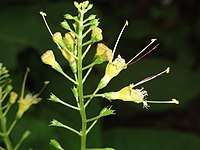Collinsonia canadensis
Collinsonia canadensis, commonly called richweed,[1] is a perennial herb in the mint family.
| Collinsonia canadensis | |
|---|---|
 | |
| Scientific classification | |
| Kingdom: | Plantae |
| Clade: | Tracheophytes |
| Clade: | Angiosperms |
| Clade: | Eudicots |
| Clade: | Asterids |
| Order: | Lamiales |
| Family: | Lamiaceae |
| Genus: | Collinsonia |
| Species: | C. canadensis |
| Binomial name | |
| Collinsonia canadensis | |
It is native to eastern North America, primarily east of the Mississippi River, where it is widespread. It is the most broadly distributed member of the genus Collinsonia,[2] ranging north to Quebec and south to Florida.[3] Its natural habitat is nutrient-rich mesic forests, most often in rocky, calcareous areas.[4][5]
It produces lemon-scented flowers in mid-summer, a time when little else is in bloom in densely shaded forests.[4]
Traditional herbal use
Collinsonia canadensis was used by Native Americans to treat a variety of ailments.[2] However, European-American settlers in North America did not often use this species after they initially discovered it, due to it lacking any conspicuous toxic qualities.[6] It wasn't until the mid-1800s when it regained popularity as a medicinal herb.[7][8]
The leaves can be brewed into tea, and the subterranean stem was once used as a diuretic, tonic, and astringent.[9]
Gallery
 Detail of Collinsonia canadensis flowers.
Detail of Collinsonia canadensis flowers.
References
- "Collinsonia canadensis". Natural Resources Conservation Service PLANTS Database. USDA. Retrieved 17 December 2017.
- Yatskievych, George (2013). Flora of Missouri, Volume 3. Missouri Botanical Garden Press. p. 312.
- "Collinsonia canadensis". County-level distribution map from the North American Plant Atlas (NAPA). Biota of North America Program (BONAP). 2014. Retrieved 17 December 2017.
- IllinoisWildflowers
- Alan Weakley (2015). "Flora of the Southern and Mid-Atlantic States".
- Scudder; Fyfe; Felter; Locke; Webster; et al. (1904). Mundy, William (ed.). A Treatise on Collisonia canadensis (PDF). Lloyd Brothers. Archived from the original (PDF) on 2007-06-23. Retrieved 2007-05-10.
- Cook, William (1869). Collinsonia canadensis in Physiomedical Dispensatory. Scanned and republished on Web.
- Petersen, J. Fred (1905). Materia Medica and Clinical Therapeutics.
- Niering, William A.; Olmstead, Nancy C. (1985) [1979]. The Audubon Society Field Guide to North American Wildflowers, Eastern Region. Knopf. p. 571. ISBN 0-394-50432-1.